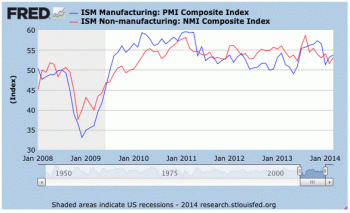John Davidson’s Economic Comments: Week ending April 4
The economic releases for the U.S. and Europe reflected the firming of the economic expansion, but showed no signs of the hoped-for acceleration. The U.S. Employment Report showed the broadening of the jobs recovery, but the improvement was not sufficient to cause the Federal Reserve to hasten the onset of monetary tightening. Purchasing Managers' Surveys remained mostly in the expansion zone even though many of the surveys were lower than they were in February. Japan's PMI's were better, but China's were softer. In spite of a sell-off in technology, most equity markets were higher on the week. Bond yields were mixed, but credit spreads continued to narrow. The U.S. dollar gained against the European and Asian currencies, but fell against the Looney. Energy commodity prices slipped, but metals commodity prices gained on the week.
Perspective:
An article published in the New York Times this week, The Oracle of Omaha, Lately Looking a Bit Ordinary, reported that statistician Salil Mehta contrasted Warren Buffett's outstanding 49-year record with his record of the last five years. From the beginning of 1965 through 2013, Buffett's record exceeded that of the S&P 500 index by 9.9 percentage points per year, putting him above the top 1 percentile of investors. Yet, in four of the last five years Buffett underperformed the S&P 500 as well as the average stock mutual fund investor. Had an investor looked at Buffett's 44-year record five years ago, and invested in his fund expecting returns above the indices, that investor would have been disappointed in the results. This exceptional record shows the difficulty in identifying managers who can beat their benchmarks. It re-emphasizes the warning that past performance is not indicative of future performance.
Economic Releases:
The U.S. employment report for March was softer than many had hoped, but showed that job growth was improving if ever so gradually. Non-Farm Payrolls (blue in the chart) increased 192,000, matching the increase in Private Payrolls (red in the chart). Net revisions for the prior two months added 37,000. Manufacturing Payrolls (green in the chart) slipped 1,000 in March, following a 19,000 increase in February. Not shown in the chart, the Unemployment Rate remained 6.7%; the Average Hourly Earnings were flat and the Average Workweek increased three ticks to 34.5 hours. In other employment news, Initial Jobless Claims increased 16,000 to 326,000; the four-week average of Claims increased to 319,500; Continuing Claims rose 22,000 to 2.836 million.
The Institute for Supply Management's Purchasing Managers Indices also showed improvement in March. The Manufacturing PMI rose to 53.7; the Services PMI rose to 53.1; both remained well into the expansion zone, above 50. The Markit PMI for Manufacturing fell two points to 55.5; the Markit PMI for Services rose two points to 55.3.
Other Economic Releases
In other U.S. releases, Factory Orders increased 1.6% and Construction Spending increased +0.1% in February.
The European Central Bank met and kept its key interest rates unchanged. The PMI's slipped in March, but remained well above 50, the demarcation between expansion and contraction; the PMI for Manufacturing slipped two ticks to 53.0; the Markit PMI Composite slipped to 53.1 while the Markit PMI for Services fell to 52.2. The EU's fourth-quarter GDP rose only +0.2% from the previous quarter. The EU's Unemployment Rate fell a tick to 11.9% and Retail Sales rose +0.4% in February. Germany's PMI's matched the EU's, but at higher levels; the Markit PMI Composite fell to 54.3 and the Markit PMI for Services fell to 53.0; the PMI for Manufacturing fell a point to 53.7. Germany's Unemployment Rate fell a tick to 6.7% and Retail Sales increased 1.3% in February. France's fourth-quarter GPD increased +0.3%; its PMI's moved into the expansion zone to 51.8 for the Markit Composite and 51.5 for the Markit Services PMI; the French PMI for Manufacturing crossed into the expansion zone to 52.1. The British PMI's also fell, but remained well above 50; the UK CIPS/PMI Manufacturing and Services each fell a point to 55.3 and 57.6 respectively.
China's PMI's were softer. The HSBC Services PMI rose a point to 51.9, but the Composite PMI slipped a half point to 49.3; the Manufacturing PMI fell a half point to 48.0; the CFLP Manufacturing PMI rose a tick to 50.3. The Japanese PMI's rose in March; the Composite rose to 52.8; the Services rose to 52.2.
Equities Markets:
A technology sell-off hit the Nasdaq, but elsewhere stocks were higher on the week. With the start of the new quarter the table below shows the quarter-to-date numbers from the end of March and the year-to-date numbers from the end of December.
Bond Markets:
Government Bond yields were mixed this week with some of the prior steepening reversed by lower two-year yields and higher 30-year yields. Credit spreads continued to narrow as investors sought to take on more credit risk.
Currencies & Commodities:
The U.S. dollar was stronger against the European and Japanese currencies, but slipped against the Looney. Energy commodity prices fell, but metals commodity prices rose on the week.





























